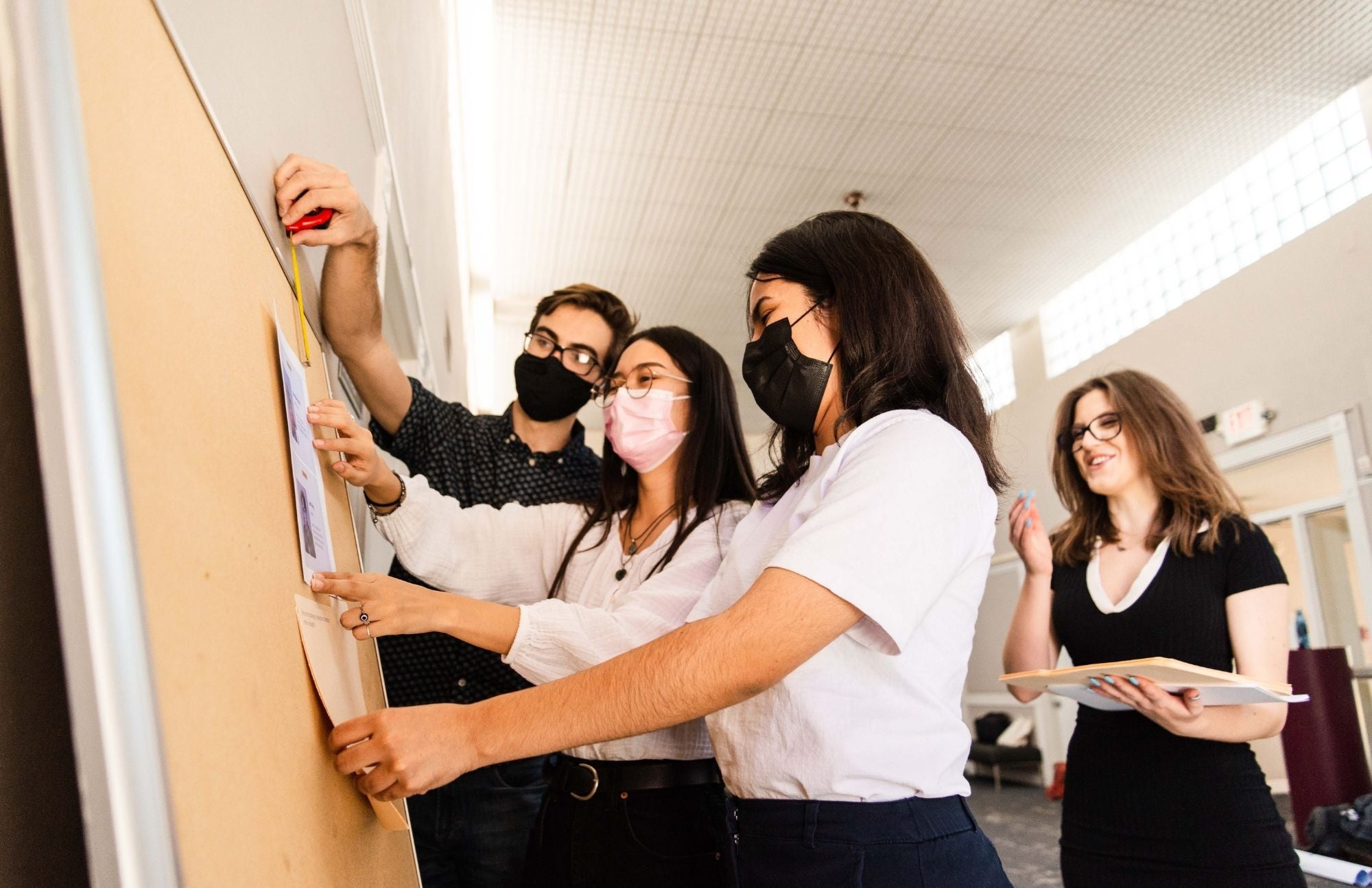The best of both worlds: Design and theater students work together on recent production

Students from the School of Music, Dance and Theatre perform in the production of "the living'life of the daughter mira" by Matthew Paul Olmos. Photo by Tim Trumble
One of the great things about the Herberger Institute for Design and the Arts at Arizona State University is the chance for designers and artists from different fields to work together.
Students from The Design School and the School of Music, Dance and Theatre recently collaborated to create the lobby displays for the ASU Theatre production of “the living’life of the daughter mira.”
Third-year design students Eni Blloshmi, Danitza Govea, Ryan Peterson and Raini-Skye Rogers worked with dramaturge Maxwell Plata, a senior undergraduate theater student, to help tell the story behind the production.
The four design students were chosen out of 14 teams, all part of design faculty Lisa Peña’s visual communication class. The teams were organized in the fall and made their first presentations in January, and the final team was selected in early March.
“Dramaturges are inherently bridge-builders — we are always looking to forge mutually beneficial connections across disciplinary lines,” said Karen Jean Martinson, assistant professor of dramaturgy in the School of Music, Dance and Theatre. “It seemed like a perfect fit for us to partner with the design students.”
Peña said she agrees that the partnership worked extremely well and that she looks forward to more partnerships like this going forward.
“When (Martinson) contacted our program, we jumped at the chance to collaborate with the dramaturgy group,” said Peña. “Our students have experience developing designs for clients, but those individuals usually are not in the creative field. Working with the dramaturgy group has been fun and refreshing. It would be wonderful to join forces again in the future.”
Students from The Design School designed the dramaturgical displays for the lobby. Photo by Tim Trumble
The winning students gathered together the week before the show to install their designs. Peterson reflected on how working from a script provided them with a unique set of challenges.
“Working with the theater program, we really had to dig into the story of the play and understand the context of it, then base our ideas around that,” said Peterson. “It’s different from some of our other work where we have a preliminary idea and then create a design.”
Rogers said she felt their team was chosen because they had been deliberate with their design choices and how it would look into the space.
“We really took into account how to display the text with the visuals,” she said, “and how it would be seen by the public.”
Plata said he enjoyed seeing the design students respond to the script. He said he felt all the teams created successful designs, but that the selected team really grasped the feeling of the play.
“I definitely chose them because they understood the meaning of the play and how to deliver it to the audience the best,” said Plata.
As dramaturge, Plata researches the story behind the play: the context in which the playwright wrote the story, the setting of the work and the social implications of the material.
The production is an original play by award-winning playwright Matthew Paul Olmos. It tells the story of a premature baby struggling to survive in the neonatal intensive care unit while her teenage mother, extended family and father grapple with her arrival.
For this play, Plata researched and wrote about teenage pregnancy in America, neonatal intensive care units in hospitals and the poetic language of the playwright.
The design students created displays that incorporated production elements from the show and echoed hospital signage. The signs included information about the playwright as well as the show’s topics. On another wall, they created hanging folders to look like hospital patient files with information and quotes from the cast members as well as design samples and cue sheets from the artistic team. They also created an interactive element where audience members could place their dreams and promises for the future in an aquarium filled with sand, designed to look like the beach where much of the play takes place.
One of the design students said doing this project broadened her perspective and changed the way she looked at future career options.
“Before this, I was looking at jobs in packaging design or business, but now I’m looking into museums and other arts organizations,” said Blloshmi. “Doing something this large was intimidating to me before, but after doing this, I’m a lot more comfortable and found out I really enjoyed it.”
“the living’life of the daughter mira” runs through April 3 in the Lyceum Theatre at the ASU Tempe campus. Tickets must be purchased in advance through the Herberger Institute box office.
Watch a virtual walkthrough of The Design School students’ renderings.
More Arts, humanities and education

ASU+GSV Summit brings experts together to discuss advancements in education
Arizona State University President Michael Crow kicked off the ASU+GSV education technology summit in San Diego on Monday with a…

ASU professor's project helps students learn complex topics
One of Arizona State University’s top professors is using her signature research project to improve how college students learn…

Award-winning playwright shares her scriptwriting process with ASU students
Actions speak louder than words. That’s why award-winning playwright Y York is workshopping her latest play, "Becoming…


